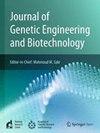Green synthesis of silver nanoparticles using Padina commersonii: Characterization, hypoglycemic effects, and antimicrobial potential against human pathogenic bacteria
IF 2.8
Q3 Biochemistry, Genetics and Molecular Biology
Journal of Genetic Engineering and Biotechnology
Pub Date : 2025-05-03
DOI:10.1016/j.jgeb.2025.100493
引用次数: 0
Abstract
Background
Nanotechnology is a dynamic field comprising chemistry, physics, biology, and engineering, with a high proficiency in disease treatment delivery methods. Metallic precursors (e.g.,AgNO3) are widely used to synthesize NPs. But, owing to their harmful nature and the cost of these metallic nanoparticles, the focus is shifting toward “green synthesis“ of nanoparticles using fungi, bacteria, plants, and algae. Hence, we used Padina commersonii to green synthesize NPs. We focused on the antioxidant, hypoglycemic, and antimicrobial efficacy of biologically synthesized AgNPs from P. commersonii.
Methods
Silver NPs (AgNPs) were synthesized using 80% methanol extract of P. commersonii upon removal of pigments and polysaccharides. Methanol (80%) was selected for higher polyphenol yield (∼30% w/w) compared to aqueous extracts (∼12% w/w), critical for efficient Ag+ reduction. Major phytochemicals, including fucoidan, phlorotannins, flavonoids (quercetin), and terpenes, are present in 80% methanol extract of P. Commersonii The NPs were characterized using ultraviolet–visible spectroscopy, Fourier transform infrared spectroscopy (FTIR), Raman spectroscopy, dynamic light scattering, energy dispersive X-ray (X-ray diffraction (XRD), and scanning electron microscopy (SEM). Antioxidant potential was determined using DPPH and ABTS scavenging assays, while hypoglycemic activity was conducted using alpha-glucosidase and alpha-amylase enzyme inhibitory assays. Finally, antimicrobial activities were conducted against S. aureus, E. coli (bacteria), and the fungal strains Candida albicans and Aspergillus niger.
Results
The AgNPs were confirmed by the colour change from yellow to brown. Further, the UV and Raman spectrophotometry peaks, respectively, at 424 nm and 335 cm-1, confirmed the presence of AgNPs. The average AgNPs size of 73.19 nm was obtained using the dynamic light scattering (DLS) technique, while the zeta potential indicated its stability at −21.5 mV. The SEM imaging confirmed a smooth surface with no aggregation, whereas the XRD pattern perceived the crystalline nature of these AgNPs. The antioxidant potential of AgNPs was higher than (DPPH: IC50: 271.17 ± 3.992 and ABTS: IC50 195.03 ± 5.7535 µg/mL) the methanol extract. Similar patterns were observed with the hypoglycemic potential with α-glucosidase (IC50:161.74 ± 3.992 µg/mL) and α-amylase inhibitions (IC50: 176.70 ± 5.7535 µg/mL). The antimicrobial efficacy of AgNPs was evident for studied bacterial species (S.aureus:12.77 ± 0.58 mm; E.coli:15.27 ± 0.58 mm) and fungi (A. niger: 18.10 ± 0.15 mm; C.albicans: 17.4 ± 0.57 mm).
Conclusions
The AgNPs displayed potent antidiabetic and antimicrobial efficacy, suggesting their potential as viable alternatives to conventional antibiotic and antidiabetic drugs.

绿色合成银纳米颗粒:表征,降糖作用,以及对人类致病菌的抗菌潜力
纳米技术是一个包含化学、物理、生物和工程的动态领域,在疾病治疗递送方法方面非常熟练。金属前驱体(如AgNO3)被广泛用于合成NPs。但是,由于这些金属纳米粒子的有害性质和成本,研究的重点正在转向利用真菌、细菌、植物和藻类进行纳米粒子的“绿色合成”。因此,我们利用Padina commersonii绿色合成NPs。我们重点研究了从商业疟原虫中生物合成的AgNPs的抗氧化、降糖和抗菌功效。方法以80%甲醇提取液为原料,去除色素和多糖,合成银NPs (AgNPs)。与水提取物(约12% w/w)相比,选择甲醇(80%)可获得更高的多酚收率(约30% w/w),这对有效还原Ag+至关重要。利用紫外-可见光谱、傅里叶变换红外光谱(FTIR)、拉曼光谱、动态光散射、能量色散x射线(x射线衍射(XRD))和扫描电镜(SEM)等方法对其进行了表征。采用DPPH和ABTS清除法测定抗氧化能力,采用α -葡萄糖苷酶和α -淀粉酶抑制法测定降糖活性。最后,对金黄色葡萄球菌、大肠杆菌、白色念珠菌和黑曲霉进行了抑菌活性测定。结果AgNPs的颜色由黄色变为棕色。紫外光谱和拉曼光谱分别在424 nm和335 cm-1处证实了AgNPs的存在。动态光散射(DLS)技术得到AgNPs的平均尺寸为73.19 nm, zeta电位表明其在- 21.5 mV下稳定。SEM成像证实了AgNPs表面光滑,没有聚集,而XRD图显示了这些AgNPs的结晶性质。AgNPs的抗氧化能力高于甲醇提取物(DPPH: IC50: 271.17±3.992)和ABTS: IC50: 195.03±5.7535µg/mL)。α-葡萄糖苷酶(IC50:161.74±3.992µg/mL)和α-淀粉酶抑制(IC50: 176.70±5.7535µg/mL)的降糖电位也有类似的规律。AgNPs对所研究的细菌种类(金黄色葡萄球菌:12.77±0.58 mm;大肠杆菌:15.27±0.58毫米)和真菌(a .尼日尔:18.10±0.15毫米;白色念珠菌:17.4±0.57 mm)。结论AgNPs具有较强的抗糖尿病和抗菌作用,有可能成为常规抗生素和降糖药的可行替代品。
本文章由计算机程序翻译,如有差异,请以英文原文为准。
求助全文
约1分钟内获得全文
求助全文
来源期刊

Journal of Genetic Engineering and Biotechnology
Biochemistry, Genetics and Molecular Biology-Biotechnology
CiteScore
5.70
自引率
5.70%
发文量
159
审稿时长
16 weeks
期刊介绍:
Journal of genetic engineering and biotechnology is devoted to rapid publication of full-length research papers that leads to significant contribution in advancing knowledge in genetic engineering and biotechnology and provide novel perspectives in this research area. JGEB includes all major themes related to genetic engineering and recombinant DNA. The area of interest of JGEB includes but not restricted to: •Plant genetics •Animal genetics •Bacterial enzymes •Agricultural Biotechnology, •Biochemistry, •Biophysics, •Bioinformatics, •Environmental Biotechnology, •Industrial Biotechnology, •Microbial biotechnology, •Medical Biotechnology, •Bioenergy, Biosafety, •Biosecurity, •Bioethics, •GMOS, •Genomic, •Proteomic JGEB accepts
 求助内容:
求助内容: 应助结果提醒方式:
应助结果提醒方式:


